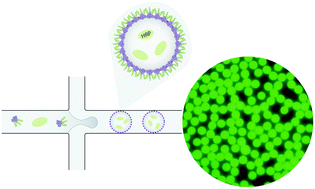Microfluidic formation of proteinosomes†
Abstract
Herein we describe a novel microfluidic method for the generation of proteinosome micro-droplets, based on bovine serum albumin and glucose oxidase conjugated to PNIPAAm chains. The size of such water-in-oil droplets is regulated via control of the input reagent flow rate, with generated proteinosome populations exhibiting narrower size distributions than those observed when using standard bulk methodologies. Importantly, proteinosomes transferred from an oil to an aqueous-environment remain intact, become fully hydrated and exhibit an increase in average size. Moreover, functional proteinosomes prepared via microfluidics exhibit lower Km values and higher enzymatic activities than proteinosomes produced by bulk methodologies.



 Please wait while we load your content...
Please wait while we load your content...